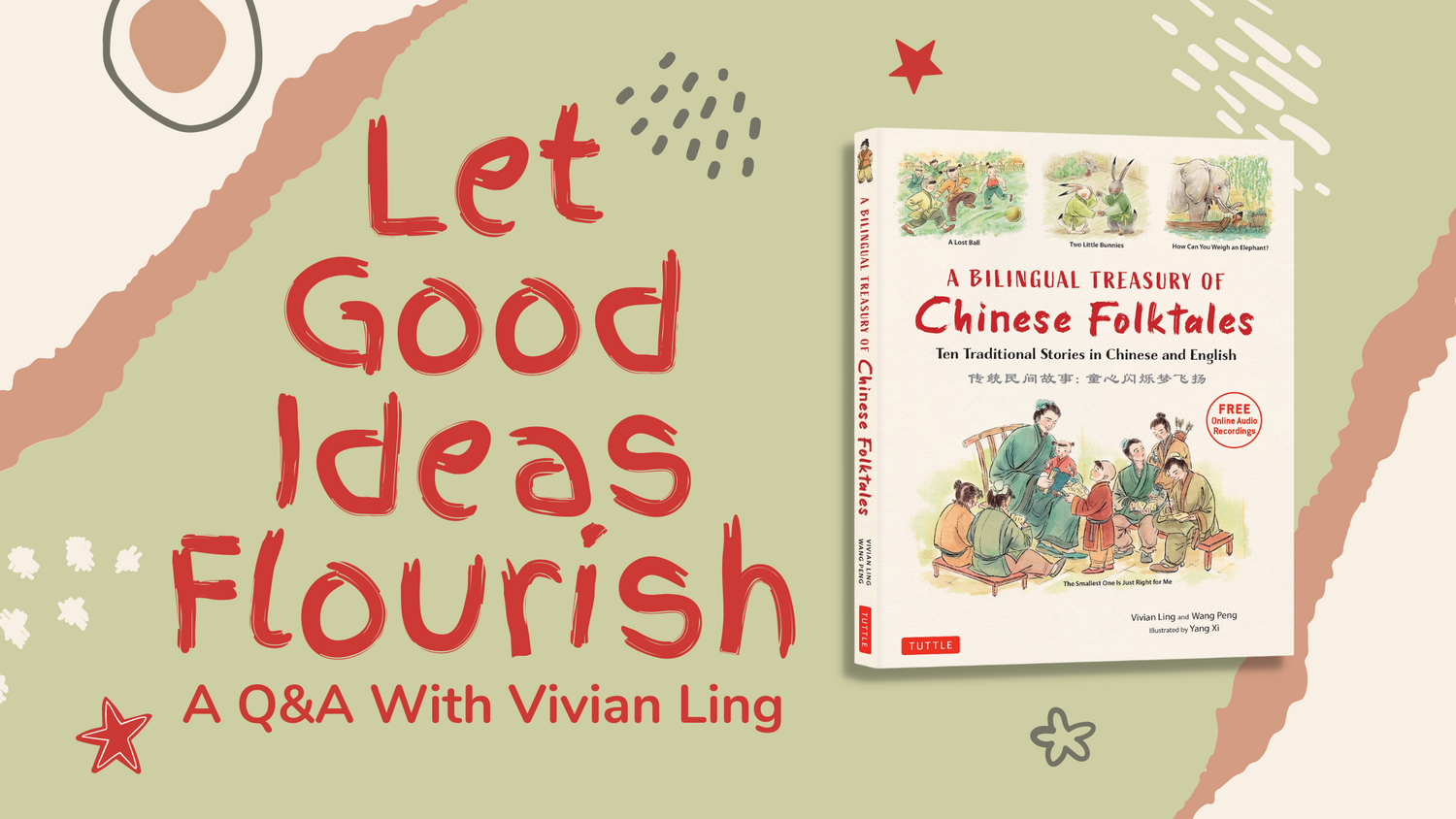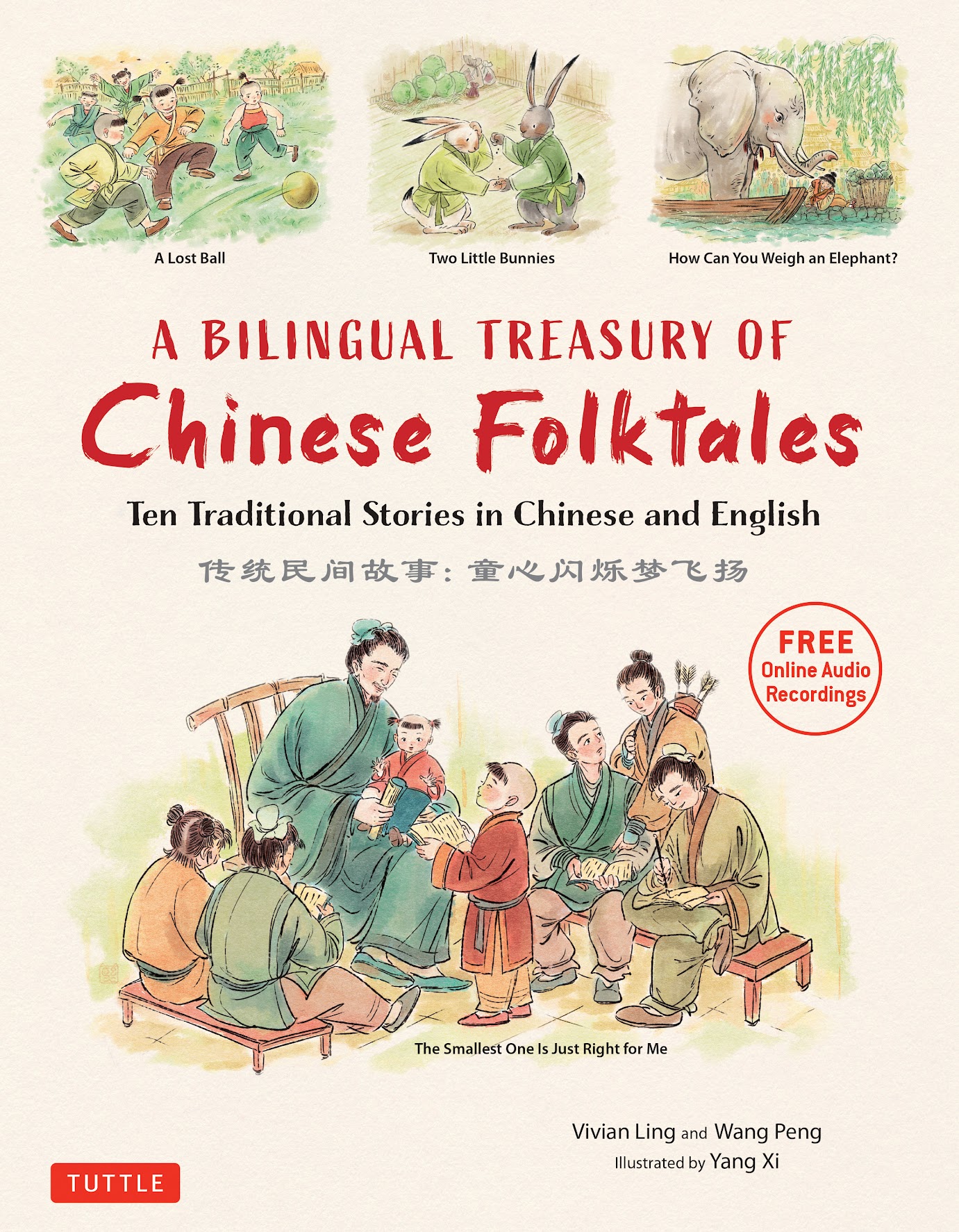Today we are speaking with Vivian Ling, co-author (alongside Wang Peng) of the upcoming Tuttle release, A Bilingual Treasury of Chinese Folktales. Vivian has enjoyed a long career as an educator and author, and she brings a wealth of knowledge about Chinese culture and language to this title. It’s a beautiful book (illustrated by Yang Xi) with entertaining stories that readers of all ages will enjoy! You can preorder or purchase here.
Congrats on the almost-release of your new book, Vivian! It’s a wonderful title. Can you tell us a bit about your background, and what brought you to this book project?
Becoming a writer of children’s books is the result of late-life discovery of a new line of creativity for me, sort of like how Grandma Moses became an artist. Shortly before embarking on this new career, I had completed forty-plus years of teaching Chinese language and culture at the college level, and capped off that career with the publication of The Field of Chinese Language Education in the U.S., A Retrospective the the 20th Century. While my academic career was immensely rewarding, I have all along been envious of the robust intuitive intelligence in children, the abundant teachable moments they offer, and their superior talent for cultural and linguistic learning. This book was my first attempt at tapping into the tremendous capacity of young minds to absorb culture, language, and behavioral learning. The promise of success in expanding the vision of the world in children was the chief motivation for this endeavor. My faith in this is embossed in the Chinese subtitle of this book: 童心闪烁梦飞扬 The Child’s Heart Sparkles and Their Dreams Soar!
As the title implies, the book is an anthology of traditional Chinese stories. How did you select the folktales to include in the book?
There is such a large trove of folktales in Chinese culture that one can literally pull them out of a hat and come up with an excellent selection. But I did use two parameters to narrow my choices: 1) stories with universal timeless significance, relevant to young people growing up in the first half of the 21st century; 2) stories that appeal to the young-at-heart, regardless of their age, i.e., stories that can grab the attention of the reader and subtly lead them to the hidden “messages.”
Do you have a favorite story in Bilingual Treasury? If so, tell us about it!

Wow! That’s a tough one! I love them all, and it’s hard to play favorites! But if I had to choose one, it would be “The ‘Princess’ Who Brought Peace.” This is a true piece of history in Sino-foreign relations from 2000 years ago, and it has relevance to our contemporary world, within single multi-ethnic multi-cultural nations, as well as among nations of the global village. One might think this is a very deep story appropriate for mature readers, but the way it is told in this book – with the illustrations and all that - makes it totally understandable to elementary grade children. In fact, children may find it especially tantalizing because they are getting a secretive glimpse of the adult world.
One of the best parts of this title is the bilingual presentation – parallel English and Chinese text on each page. How will readers benefit from this format?
We made this book bilingual to show how ideas can be passed across different languages, and that wisdom is universal. From the point of view of the publisher, bilingual books can capture a broader audience. Anyone who knows either Chinese or English can enjoy this book. And the lucky ones who know both languages can have some additional fun hopping from one language to the other, like hearing the different sounds that express the same music, joined in a complex symphony. From the point of view of language teachers, the bilingual format provides a bridge between the two languages, so that students would have a fun way to rise up to the challenge of learning that second language. This is especially true when Chinese is involved, because it can be a very daunting language for non-native speakers. Even for readers with no prior exposure to the second language, having it on the page would pique their curiosity and possibly lead to serious learning.
Who is your intended audience for this book, and what are your hopes for them?
The Amazon website has this book pegged at the age 10-13 reading level, but we intended it to be for all readers young at heart regardless of age. Before submitting the final manuscript, we actually engaged a 6-year-old boy and a 10-year-old girl to preview the draft of the text. Both of them found the vocabulary as well as the content to be “just right.”
Our greatest hope for this book is to promote the notion that good ideas from any culture should have a chance to flourish everywhere in the world. Stories from a particular culture are often appreciated for their exoticness, but we hope this treasury of Chinese folktales will go beyond its original niche and become part of the mainstream culture. We the co-authors and illustrator of this book are originally from China, but our lives have been greatly enriched by absorbing the good ideas from the western world, so naturally we would like to share some of the best ideas from our native culture with our friends around the world.
In a broader sense, can you speak to the need for multicultural education in our current time and place?
Modernization has brought humankind into a truly multicultural world. The opportunities for a splendid material and spiritual life are enormous, and so are the opportunities for conflict. It is only through multicultural education that our generation and those after us will minimize conflict and optimize the positive opportunities. The stakes for our future cannot be higher.
Do you have any upcoming projects to tease?
 The collaboration among the co-authors and illustrator for this book did not begin with a blueprint, but rather developed organically. It was only when the book was nearing completion that we realized what a marvelous tripod we formed, each with unique but complementary strengths. This book is truly a case of a whole that is greater than the sum of its three parts. We enjoyed this project so much that we cannot stop at just one. We are in fact in the midst of producing a second book, tentatively titled The Twelve Animals of the Chinese Zodiac: Stories and Wisdom.
The collaboration among the co-authors and illustrator for this book did not begin with a blueprint, but rather developed organically. It was only when the book was nearing completion that we realized what a marvelous tripod we formed, each with unique but complementary strengths. This book is truly a case of a whole that is greater than the sum of its three parts. We enjoyed this project so much that we cannot stop at just one. We are in fact in the midst of producing a second book, tentatively titled The Twelve Animals of the Chinese Zodiac: Stories and Wisdom.
In addition, I have another book idea already queuing up in the back of my mind, one that I have not even mentioned to my team, so you are the first to hear about this. I don’t have a title for it yet, but the theme will be Chinese proverbs illustrated by stories from around the world. For me to succeed in producing books that speak to the current generation, I need to engage in continuing self-education, to learn how the way young people are learning is changing in the contemporary world. No doubt about it, it is changing fast. And this is a huge challenge for the publishing industry as a whole. Looking towards the book on proverbs with contemporary relevance, I will apply this proverb to myself: “live to an old age, learn to an old age, never stop learning!”
Thanks so much for participating in this Q&A! Before we go, do you have any parting thoughts to share about education and publishing in general?
As I see it, educators and publishers are paying more and more attention to the need for multicultural education. In terms of materials that address linguistic diversity, in the U.S., there are some great multicultural materials in Spanish and English, but good materials that bridge over to Asian languages and culture are still in short supply. In this regard, I see Tuttle as a leading force in bridging that gap.
The timeless wisdom of Chinese folktales presented in parallel English and Chinese texts!
These traditional Chinese tales are fun to read and each one contains a gentle moral telling kids how to be a good person and live a good life. The stories are presented with parallel English and Chinese texts on every page, along with dozens of charming color illustrations by illustrator Yang Xi.


